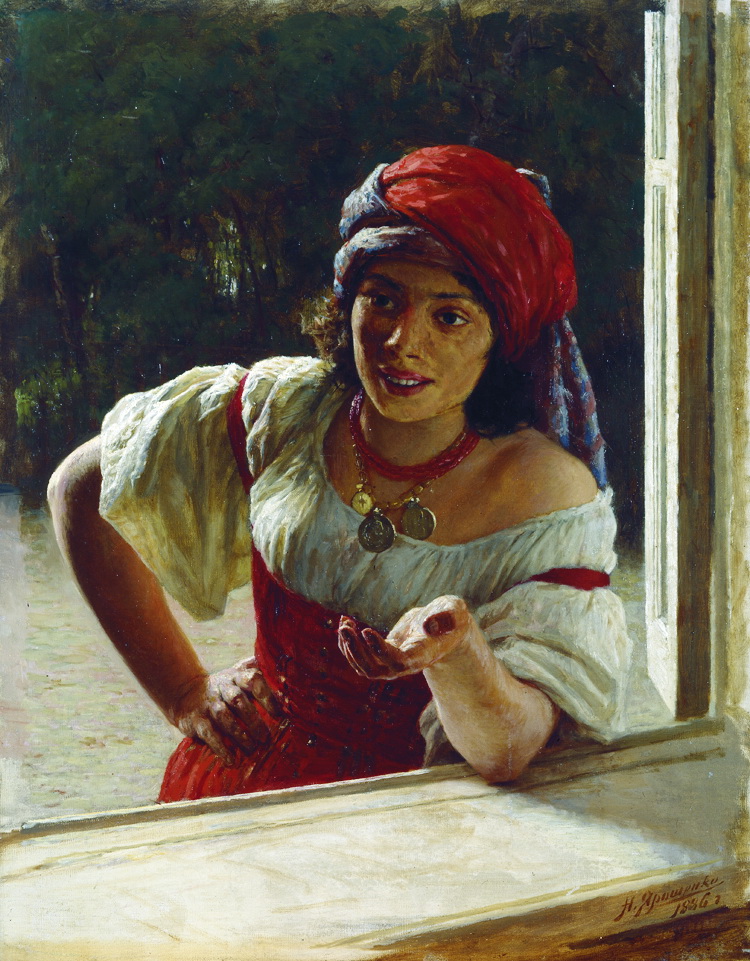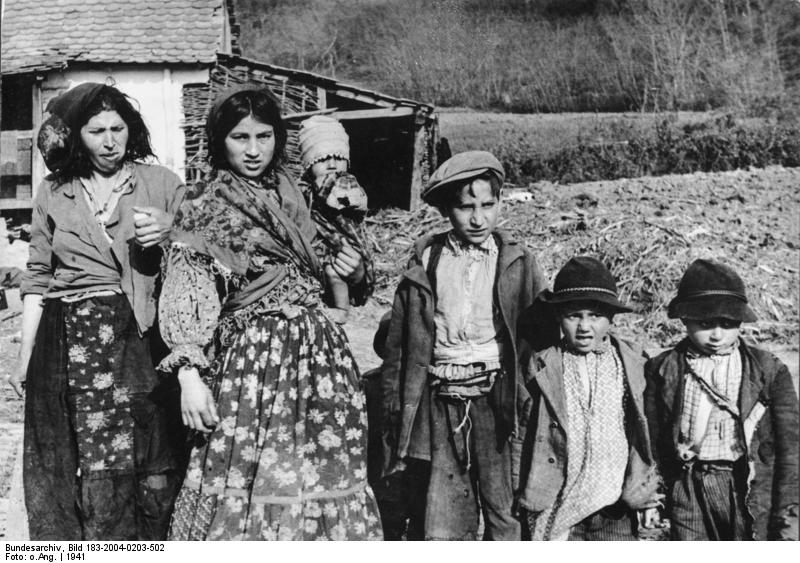
Nikolai Yaroshenkos „Zigneunerin“ zeigt uns das bekannte Klischee der bettelnden, verführerisch-exotischen Schönheit
„Zigeuner“, so nennt man sie für gewöhnlich – und auch wenn man weiß, dass das Wort heute verpönt ist, so sind damit doch viele Bilder verknüpft: Wohnwagenkolonien, Musik und verführerische Frauen, die ums Feuer tanzen und ihre schwarzen langen Locken hin und her werfen. Na, habt ihr auch schon Carmen oder Esmeralda im Kopf?
Das ist eines der populären Bilder von Romani*) – ein anderes kennen wir gerade als Reisende aus eigener Anschauung: armselige, zerlumpte Bettler, die entweder den ganzen Tag flehentlich kniend um Geld bitten oder durchaus schon einmal aggressiv werden können, wenn man es ihnen nicht gibt. Und obendrein muss man sich natürlich vor Taschendieben unter ihnen in Acht nehmen.
Aber wer sind sie denn nun wirklich, diese Romani*)? Sie gehören zu der Volksgruppe, der gegenüber ich sehr lange selbst sehr starke Vorbehalte hatte, denn wann immer sie für mich als Romani*) erkennbar waren, fielen sie mir negativ auf. Es gab einfach keinen einzigen Fall, in dem Roma oder Sinti positiv als solche aufgefallen und erkennbar gewesen wären. Warum war das so?
Ich wollte diese Vorurteile angehen und kam so mit Martina in Kontakt, einer in Slowenien lebenden Italienerin, deren Forschungsschwerpunkt die vielfältigen Diskriminierungen sind, mit denen Roma täglich konfrontiert werden und die sich schon seit Jahren für die soziale Integration dieser Minderheit einsetzt.
Ich bat sie, einen Artikel über die Romani*) für unser Blogprojekt „Blogger gegen Rassismus“ zu schreiben – was sie mit Freuden getan hat. Ein weiterer Beitrag zu Roma Museen, Restaurants und B&Bs soll folgen.
*) Martina verwendet das Wort Romani für die Ethnie, während das Wort im Deutschen eher für die Sprache gebräuchlich ist. Ich habe hier das von Martina verwendete Wort gebraucht, da es im Deutschen lediglich Bezeichnungen wie „Sinti und Roma“ etc. gibt (die andere Gruppen wohl wiederum außen vor lassen), während Sammelbezeichnungen wie „Zigeuner“ oder „Fahrendes Volk“ als abwertend oder pauschalisierend empfunden werden – und leider existiert auch kein deutsches Adjektiv. Falls ihr die korrekte deutsche Entsprechung zu Romani kennt, lasst es mich bitte wissen.
Who are the Romani people and where do they come from?

Romani people in Wales, 1950s (c) Geoff Charles Lizenz: CC0 1.0
The Romani people are the most discriminated and marginalized people of Europe. During time, they were persecuted, arrested, deported and killed and, even nowadays, their story is far from having a happy ending. Prejudices and exclusion are a common reality for many Romani women and men.
But who are the Romani people? They are a population that originated in North-Western India and travelled all its way to Europe. The time of the Romani diaspora is believed to be around the 11th Century, when the Muslims conquered India. From that time, the Romani people, in origin probably called Dom, travelled to new lands. Some groups get settled in the Middle-East and took the name of Dom, in the Arab Countries, and Lom, in Armenia. They are still living in these countries and working as musicians, street performers and blacksmiths. They do not live a nomadic lifestyle, but are usually marginalized in particular villages or settlements. They are often addressed as Nawar by the majority population. Nawar means “lights” in Arabic, but it takes a negative connotation when addressed to the Dom.
Other Romani communities arrived in Europe around the 13th and the 14th centuries. The extended families used to travel inside a specific Country of region, performing traditional crafts. Among them, we would have found blacksmiths, horse dealers, basket weavers, carpenters, copper smiths and many more. Especially in Eastern Europe, many Romani communities took their name from the traditional handicraft performed by their extended family.

Romani people in Croatia, 1941 Foto: Deutsches Bundesarchiv. Lizenz CC-BY-SA 3.0-de
Through centuries of life in Europe, the Romani culture was re-shaped. While some aspects of the ancient Indian culture remained, more or less strong, in some Romani groups, many communities adopted the uses of the local population, fused them with their own costumes and created a unique pattern of different Romani cultures and traditions. Still nowadays, many Romani communities follow a pattern of solidarity among the family members, respect for the elderly and education called Romanipen. This is a pattern of values that can go from simple solidarity to peculiar way to dress and behave, according to the Romani group that is using it.
The Romani culture is so far to be unique and homogeneous, that we can actually speak of Romani cultures, in a plural form.
However, since their arrival in Europe, their bizarre appearance, with their dark skin, colourful clothes and different lifestyle, made the Romani people to be an easy target for prejudices and legends. Especially Roma women were often accused to be witches and to be able to perform witchcrafts. This was the starting point of centuries of persecutions that are still nowadays leaving their traces. The darker chapter of this persecution was the Porrajmos (or Samudaripen), the Romani Holocaust performed by the Nazi and their allies. In many European countries, the Romani people were persecuted, killed, sterilized and became the object of scientific experiments. It is estimated that from 500.000 to a million and a half of Roma died during the Porrajmos, at that time the 2/3 of the Romani population.

Deportation of Sinti and Roma, Asperg, 1940. Foto: Deutsches Bundes Archiv. Lizenz: CC-BY-SA 3.0-de
Discrimination today
Unfortunately, the effects of centuries of discrimination cannot be cancelled in a few years. Still nowadays, many people believe that the Romani people are connected to witchcrafts, are thieves, lazy and beggars. Other would have positive stereotypes connected to freedom, wandering and music. Personally, these “positive stereotypes” make me cringe a little less than the negative ones, yet they make me cringe.

Roma settlement in Slovakia. Foto: Matus Kacmar. Lizenz: CC 2.0 Generic
I’ve met many Romani people, during my work and activism with them, for their rights and social inclusion. I’ve met Roma, Sinti, Manouches, Kalé and Romanichaels and every individual had her/his own characteristics. Some were poor, some were wealthy, some were excluded and unemployed, other had an academicals education and were successful. Some do not even liked music nor traveling!
When I talk with the majority population, I notice that they never or rarely encountered a Roma person, if they did it’s often because they were either not able to recognize the individual as a Roma or because she/he responded to the common image of the “gypsy”.
With the first statement, I want to describe the situation when the individual does not present any of the stereotypical “gypsy” characteristic. Maybe you have met a kind, professional, well-dressed person with a university diploma who was Roma but did not introduced herself as so. On the other hand, you have maybe encountered a poor, bad dressed beggar, maybe a mother with a few children, that perfectly fit in the common image given to the Roma. In that case, you would be able to recognize the person ethnicity. This could lead you in thinking that, as you recognized only the poor beggar Roma as such, then all the Roma would be actually poor and beggar.
While it is normal for our brain to try to categorize anyone and anything external to our social sphere in the simplest way as possible (through stereotypes), it is our due as individuals to go above these categories and to know the person as she/he really is.
This is even more important for travellers and for ones who are willing to discover new cultures. Let me give you an example, I’m an Italian woman, and the stereotype would see me as deeply Catholic, submitted and unable to speak any foreign language, oh and probably even as a member of a mafia clan (not one of the given examples is the case). Now, I doubt that you wold apply these stereotypes to me, as they would be seen as unacceptable.
Yet, the stereotypes towards the Romani people are still widespread and rarely criticized. Personally, I think that we need to question ourselves on that.

About Martina:
I’m an Italian woman living in Slovenia and a PhD student on Ethnic and migration studies at the University of Ljubljana. I’m researching on multiple discrimination towards the Roma people and its effect on youth’s identity. I’ve been working in the field of Romani people social inclusion, identity and anti-discrimination policies and actions for five years so far.
„Gypsys, Tramps and Thieves“ was a No 1 hitsingle by Cher in 1971 – despite the wrong spelling („Gypsies“ would be the right one) – I kept it in the title the way Cher wrote it on her single cover.
Sehr, sehr interessant!
Es ist so, dass der gebildete Roma intergriert ist und nicht weiter auffällt. Wenn, dann fallen Roma auf, wenn sie in Verbindung mit Negativem gebracht werden. Die Südosteuropäischen Bettler, die zum Beispiel Hamburg unsicher machen, stammen nachgewiesenermaßen zu einem großen Teil aus einem Roma-Dorf in Rumänien. Und eine pflegebedürftige Person im Pflegeheim, in dem auch mein Vater lebt, ist „Zigeuner“. Er bezeichnet sich selbst so. Und er bietet kein besonders positives Bild.
Andererseits bin ich ganz mit dem romantischen Bild der „Zigeuner“ in den 60er Jahren groß geworden. Ich erinnere nur an den Schlager „Zigeunerjunge“ von der damals sehr beliebten Sängerin Alexandra. Auch habe ich sie noch gesehen, die Wohnwagen-Karawanen… „Lustig ist das Zigeuenerleben…“ Das war mein Bild von den „Zigeunern“. Heute finde ich es ganz spannend, wie die Romani eine doch ganz andere Tradition sich erhalten haben und den Tendenzen zur Globalisierung und Gleichmacherei widerstehen.
Ich hoffe, ich habe nun niemanden vor den Kopf gestoßen.
Danke für den Artikel, der mich auch nachdenklich gestimmt hat!
Liebe Grüße
Ulrike
„Es ist so, dass der gebildete Roma intergriert ist und nicht weiter auffällt. Wenn, dann fallen Roma auf, wenn sie in Verbindung mit Negativem gebracht werden.“
Da sprichst du den Kernpunkt des Problems an. Ein Roma ist in unseren Augen erst dann ein Roma, wenn er die Stereotype erfüllt. Sonst nehmen wir ihn einfach nicht als Roma wahr, was zur Zementierung der Stereotype nur beiträgt.
Hallo Ilona, nun musste ich aber doch noch mal gründlich nachdenken, denn irgendwie störte mich was an der Formulierung „Ein Roma … ist erst dann ein Roma, wenn er die Stereotype erfüllt.“ Das finde ich so nicht ganz richtig. Ein Roma ist ein Roma, wenn er sich als Roma outet. Und das tun eben die Leute zum Beispiel, wenn sie sich einer Zeitung gegenüber im Interview eben nicht nur als „Bandenchef“ interviewen lassen, sondern eben auch als Clan-Chef einer Roma-Familie. So stand es vor einem Jahr in der Zeitung. Auch wir von der Bahnhofsmission wissen, wo die „Bettlerbanden“ herkommen. Aber die meisten Menschen wissen das nicht. So werden die Bettler in der Regel „osteuropäische Bettler“ genannt. Also ist es doch so, dass erst durch das bekannt werden, dass es sich um Roma handelt, die Menschen in ihren Vorurteilen bestätigt werden.
Das ist doch gleiche wie mit den Juden.So lange mir das niemand sagt, weiß ich nicht, wer Jude oder Roma oder sonstwas in meinem Freundes- und Bekanntenkreis ist. Es sind alles Menschen…
„Ein Roma … ist erst dann ein Roma, wenn er die Stereotype erfüllt.“
Ich sprach hier von UNSERER Wahrnehmung als Nicht-Roma, als Mehrheitsgesellschaft. Wir nehmen einen Roma nur als Roma wahr, wenn er erkennbar ein Roma ist. Und das ist er erst dann, wenn er die Stereotype erfüllt.
Es hat auch einen Grund, warum viele „ganz normale“, nicht als Roma auffallende Roma sich nicht outen: Denn man wird sofort die Stereotype an ihnen suchen (zumindest müssen sie damit rechnen und fürchten das) – man traut ihnen eher zu, dass sie stehlen z.B. als wenn sie sich gar nicht erst als Roma zu erkennen geben.
Wenn wir einen Menschen mit dunklerem Teint betteln sehen, dann gehen wir davon aus, dass es sich um einen Roma handelt. Ich wusste, dass das Roma sind, bevor ich je darüber gelesen oder gehört habe. Das war etwas, was ganz selbstverständlich tradiert wurde. Im Endeffekt erfüllen Zeitungen ja auch unsere Erwartungen, wenn sie die osteuropäischen Banden auch noch mal unter dem Licht des „Zigeunerkönigs“, des „Clan-Chefs“ präsentieren.
Darf ich ein Blog empfehlen? http://golden-zephyr.com/
Qristina, eine slowakisch-englische Romni, die nun in Amerika lebt, schreibt über ihren Alltag und die Geschichte ihrer Familie. Qristina ist Sprachwissenschaftlerin, Autorin und Mutter, räumt mit vielen Vorurteilen auf, und sie schreibt ganz wunderbar.
Oh danke, den merk ich mir gleich vor!
Liebe Ilona,
ein schwieriges Thema. Ich habe vor 2 Jahren versucht, das Thema zu durchleuchten und bin der Frage „Woher kommt der Begriff Zigeuner“ nachgegangen. Meinen Beitrag findest du unter https://pagewizz.com/woher-kommt-der-begriff-zigeuner-30095/ Es war nicht so einfach zu recherchieren und allen gerecht zu werden. Ich hoffe, es ist mir gelungen. Ich habe vorher das Buch „Arme Roma, böse Zigeuner“ gelesen.
In unserer Region leben seit Jahrhunderten Sinti. Es sind bekannte Musiker darunter wie Django und Lulo Reinhard. Auf dem Asterstein in Koblenz findet regelmäßig ein Musikfestival statt. Mit einer Freundin war ich 2 Mal dort. Es war sehr interessant, da viele Musiker aus ganz Europa angereist sind. Wir fühlten uns ein bisschen wie in einer anderen Welt. Auch diese Familie hat im 2. Weltkrieg sehr gelitten. Das wissen die meisten Deutschen nicht oder wollen es nicht wissen.
Liebe Grüße
Renate
Hallo Renate. Danke für deinen Kommentar und den interessanten Link.
Nur bei der Bedeutung des Wortes „Atziganoi“ habe ich eine andere Deutung. Eben nicht, dass sie diejenigen sind, die „nicht berührt werden wollen“ – sondern die „Unberührbaren“, eben die, die ganz unten im Kastenwesen stehen (oder außerhalb davon) und dementsprechend nicht berührt werden dürfen.